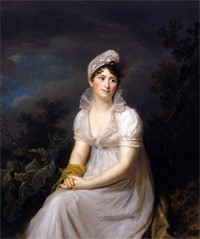Firmin Massot is today recognised as one of the principal Genevan painters of his time, the initiator of an art of the portrait in its modern meaning, as early as the late 18th century.
Son of a master watchmaker and merchant, André Massot and of Marie-Catherine née Boisdechêne, Firmin Massot was enrolled in January 1778, at the age of eleven, at the Public School of Drawing of Geneva. In 1780, he attended courses of drawing after nature (or after live models) founded by the Société des Arts and had as fellow disciples Jacques-Laurent Agasse and Adam Töpffer. His professors were Jacques Cassin, Georges Vanière, Louis-Ami Arlaud-Jurine, François Ferrière and Jean-Etienne Liotard. In April 1780 he took part in the annual competitive examinations organized by the school of the Société des Arts for its pupils. In 1781 he obtained a third prize and, in 1782, an ‘honourable’ mention. In November 1787, he was admitted, after an entrance examination, in the drawing class ‘d’après la bosse’ (after a moulded figure) recently created. From then on his talent was recognised by his contemporaries; thus, from November 1787 to June 1788, he accompanied Councillor François Jallabert on a trip to Italy. In Rome he found his compatriots, Jean-Pierre Saint-Ours and Gabriel-Constant Vaucher.
In 1789, he exhibited in the first Genevan Salon an Etude d’après nature painted in oils. In 1790, he obtained the Grand Prix «after nature» awarded by the Société des Arts. In the 1792 Salon he submitted three portraits. From this time on, he worked in collaboration with his fellow students Jacques-Laurent Agasse and Adam Töpffer; their works were very successful and, in November 1794, he was invited to stay and work at Mézery, near Lausanne, for Madame de Staêl. In April 1795, he married Anne-Louise Mégevand then aged seventeen; three children were to be born of this union.
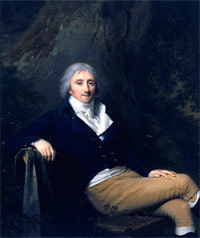
Massot took part in the 1798 Salon with a portrait and La Couseuse («The Seamstress», also known as «The Embroiderer»). From then on assistant to the Committee of Drawing of the Société des Arts, he was nominated director of the Schools of Drawing of the town of Geneva. From the 1790s, he also gave private lessons: among his pupils, Nancy Mérienne and, from 1805, Amélie Romilly (later Amélie Munier-Romilly). In 1800, he became Ordinary Member of the Société des Arts.
In October and November 1807, Massot was in Paris with Adam Töpffer and met François Gérard, Jean-Baptiste Isabey and Jules-César-Denis Van Loo. In 1812, while travelling to Lyons, still in company with Töpffer, he met the painter Fleury François Richard and the members of the Académie des lettres et arts of the town. In 1813, he was called to Aix-les-Bains to paint Queen Hortense’s portrait and found there Fleury François Richard and Jean-Antoine Duclaux.
From 1816, Massot exhibited regularly in the Salons organized by the Société des Arts of Geneva. In 1828 and 1829, he stayed in London, Liverpool and Manchester, and later went to Scotland. In London he found again Agasse and the Chalon brothers, met Thomas Lawrence and received numerous commissions for portraits. Back in Geneva, he submitted to the Salons not only portraits but also genre pictures. He exhibited in London in 1830 and 1836 as well as in Lyons in 1833. In 1844, he became Member Emeritus of the Société des Arts. Even though, from then on, his weakening eyesight impeded him from painting, he took part, with a still lively mind, until his last days, in the intellectual activity of the town.
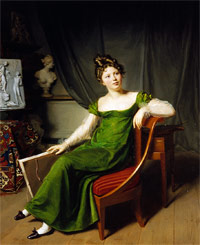
Insufficient family resources were at the origin of Massot’s essentially local training. Nonetheless, at the School of Drawing of the Société des Arts, he had high quality professors trained in Paris with Joseph-Marie Vien. Early on, he divided his activities between genre and portrait painting, then the latter activity became more important and, while collaborating with his friends, the animal painter Agasse and the landscape painter Töpffer, Massot rapidly and superbly developed this aspect. Painted for rich patrons, these combined works in which the main subjects, painted by Massot, appear full length against a landscape background, with their favourite animals, bring to mind the «Conversation Pieces» of the eighteenth century English masters. Simultaneously, Massot painted half length portraits in oils or drawn in the format of large miniatures, a reminiscence of the work of his master Louis-Ami-Arlaud-Jurine.
From 1800, Firmin Massot painted full-length portraits and portraits known as «jusqu'aux genoux» (as far as the knees), as well as head and shoulder portraits destined for family circles, hence their spontaneous and informal aspect. The backgrounds usually consisted of a landscape - often painted by Töpffer with whom he collaborated in this way until 1819 - or by an interior with different props (books, writing equipment, objets d’art) thus symbolising in addition a certain financial ease, important political, judicial or administrative responsibilities exercised by the sitters. Among them we find most of the Genevan notables and their families, as well as foreigners travelling through Geneva, French, British, German, Polish. On different occasions, Massot also painted his wife, his children, his friends, his pupils. His skill in making true to life portraits as well as the technical quality of his works were all praised by his contemporaries. Over more than half a century, making his own the precepts of his masters, Massot approached the art of portrait painting in its modern definition, privileging the ideal of likeness.
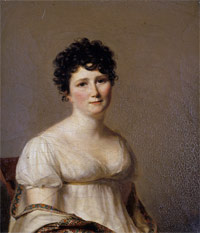
Until 1815-1820, the expression of the personality of the sitter was underlined by a pose or a carefully chosen background. The portraits elaborated later, of a freer technique gave more importance to the faces of the models: from then on the backgrounds are of great simplicity. In the 1830s, inspired by the English «Fancy Pictures», Massot came back to genre painting - [La Lecture de l’Almanach («The Reading of the Almanach») was presented in the Salon of Geneva of 1832, in Lyons in 1833 and in London in 1836].
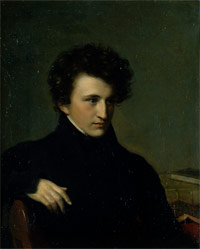
Painted or drawn, Massot’s works are rarely signed. They are today housed in museums and private collections all over the world.
Strongly appreciated during the artist’s lifetime by the most important personalities of his time, they were admired right through the 19th century. Then, in the 20th century, different authors have maintained, wrongly, that the painter had succumbed to facility and success. These allegations are based on a lack of knowledge of the work and personality of the artist. They also uphold a social criticism: the portraitist is reproached for having a clientele above all bourgeois and aristocratic.
Today, through his influence, his travels and his encounters, Massot appears as an artist of a European dimension and a founder member of the first Genevan School of Painting.
Portrait of Mme Marc-Louis Rigaud, born Marie-Anne Martin, circa 1805-1810, oil on panel, H. 41 cm ; L. 34,9 cm, Private collection ©photo Denis Ponté. Portrait of Marc-Louis Rigaud (1754-1844), circa 1805-1810, oil on panel, H. 41 cm ; L. 34,9 cm, Private collection ©photo Denis Ponté. Portrait of Amélie Munier-Romilly (1788-1875), circa 1818, oil on canvas, H. 68 cm ; L. 57 cm, Private collection ©photo Denis Ponté. Portrait of Mme Jean-Conrad Hottinguer, born Martha Elisa Redwood (1774-1830), 1808, oil on canvas, H. 30 cm ; L. 26,3 cm, Private collection©photo Renan Cholet. Portrait of Jacob-Louis Duval (1797-1863), circa 1820-1825, oil on canvas, H. 29,6 cm ; L. 25,8 cm, Private collection ©photo Denis Ponté.

